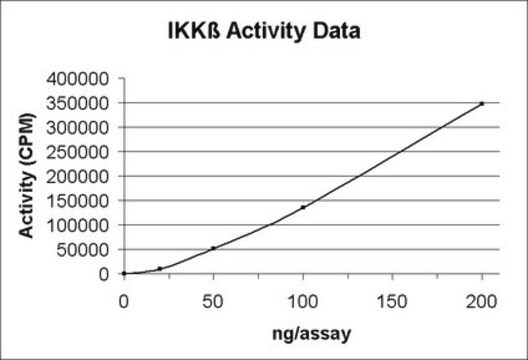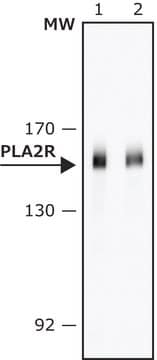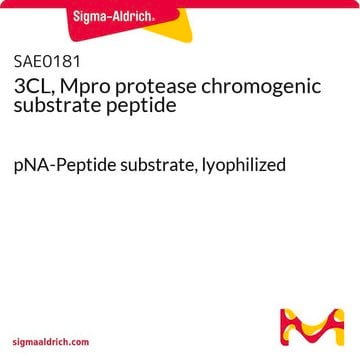Empfohlene Produkte
Beschreibung
protein target IKKβ
Qualitätsniveau
Assay
≥70%
Spezifische Aktivität
58 pmol/min-μg
Konzentration
0.1 mg/mL
Methode(n)
activity assay: suitable
UniProt-Hinterlegungsnummer
Angaben zum Gen
human ... IKBKB(3551)
Allgemeine Beschreibung
FUNCTION: SwissProt: O14920 # Phosphorylates inhibitors of NF-kappa-B thus leading to the dissociation of the inhibitor/NF-kappa-B complex and ultimately the degradation of the inhibitor. Also phosphorylates NCOA3 (By similarity).
SIZE: 756 amino acids; 86564 Da
SUBUNIT: Preferentially found as a heterodimer with IKK-alpha but also as a homodimer. Directly interacts with IKK-gamma/NEMO and TRPC4AP. The tripartite complex can also bind to MEKK1, MAP3K14/NIK, IKAP and IKB-alpha-p65-p50 complex. Phosphorylated IKB-alpha is further released from the complex. Found in a complex composed of NCOA2, NCOA3, IKKA, IKBKG and CREBBP. Interacts with SQSTM1 through PRKCZ or PRKCI. Forms an NGF-induced complex with IKBKB, PRKCI and TRAF6. May interact with MAVS/IPS1. Interacts with NALP2. Interacts with Yersinia yopJ.
SUBCELLULAR LOCATION: Cytoplasm.
TISSUE SPECIFICITY: Highly expressed in heart, placenta, skeletal muscle, kidney, pancreas, spleen, thymus, prostate, testis and peripheral blood.
PTM: Upon cytokine stimulation, phosphorylated on Ser-177 and Ser- 181 by MEKK1 and/or MAP3K14/NIK; which enhances activity. Once activated, autophosphorylates on the C-terminal serine cluster; which decreases activity and prevents prolonged activation of the inflammatory response. & Yersinia yopJ may acetylate Ser/Thr residues, preventing phosphorylation and activation, which blocks the I-kappa-B signaling pathway.
SIMILARITY: SwissProt: O14920 ## Belongs to the protein kinase superfamily. Ser/Thr protein kinase family. IkappaB kinase subfamily. & Contains 1 protein kinase domain.
SIZE: 756 amino acids; 86564 Da
SUBUNIT: Preferentially found as a heterodimer with IKK-alpha but also as a homodimer. Directly interacts with IKK-gamma/NEMO and TRPC4AP. The tripartite complex can also bind to MEKK1, MAP3K14/NIK, IKAP and IKB-alpha-p65-p50 complex. Phosphorylated IKB-alpha is further released from the complex. Found in a complex composed of NCOA2, NCOA3, IKKA, IKBKG and CREBBP. Interacts with SQSTM1 through PRKCZ or PRKCI. Forms an NGF-induced complex with IKBKB, PRKCI and TRAF6. May interact with MAVS/IPS1. Interacts with NALP2. Interacts with Yersinia yopJ.
SUBCELLULAR LOCATION: Cytoplasm.
TISSUE SPECIFICITY: Highly expressed in heart, placenta, skeletal muscle, kidney, pancreas, spleen, thymus, prostate, testis and peripheral blood.
PTM: Upon cytokine stimulation, phosphorylated on Ser-177 and Ser- 181 by MEKK1 and/or MAP3K14/NIK; which enhances activity. Once activated, autophosphorylates on the C-terminal serine cluster; which decreases activity and prevents prolonged activation of the inflammatory response. & Yersinia yopJ may acetylate Ser/Thr residues, preventing phosphorylation and activation, which blocks the I-kappa-B signaling pathway.
SIMILARITY: SwissProt: O14920 ## Belongs to the protein kinase superfamily. Ser/Thr protein kinase family. IkappaB kinase subfamily. & Contains 1 protein kinase domain.
Qualität
Evaluated by Kinase assay: 10 µl of varying amounts of IKKβ was mixed with 5 µl of 1 mg/ml IKKtide synthetic peptide substrate and 5 µl of distilled water. Reaction was initiated by adding 5 µl of 250 µM [33P]-ATP and incubating for 15 min at 30°C followed by spotting the reaction on phosphocellulose paper, fixing in 1% phosphoric acid, and assaying with a scintillation counter.
Physikalische Eigenschaften
105 kDa
Physikalische Form
50 mM Tris-HCl, pH 7.5, 150 mM NaCl, 10 mM glutatione, 0.1 mM EDTA, 0.25 mM DTT, 0.1 mM PMSF, 25% glycerol
Lagerung und Haltbarkeit
Stable for > 6 month at –80°C from date of receipt.
Haftungsausschluss
Unless otherwise stated in our catalog or other company documentation accompanying the product(s), our products are intended for research use only and are not to be used for any other purpose, which includes but is not limited to, unauthorized commercial uses, in vitro diagnostic uses, ex vivo or in vivo therapeutic uses or any type of consumption or application to humans or animals.
Analysenzertifikate (COA)
Suchen Sie nach Analysenzertifikate (COA), indem Sie die Lot-/Chargennummer des Produkts eingeben. Lot- und Chargennummern sind auf dem Produktetikett hinter den Wörtern ‘Lot’ oder ‘Batch’ (Lot oder Charge) zu finden.
Besitzen Sie dieses Produkt bereits?
In der Dokumentenbibliothek finden Sie die Dokumentation zu den Produkten, die Sie kürzlich erworben haben.
Unser Team von Wissenschaftlern verfügt über Erfahrung in allen Forschungsbereichen einschließlich Life Science, Materialwissenschaften, chemischer Synthese, Chromatographie, Analytik und vielen mehr..
Setzen Sie sich mit dem technischen Dienst in Verbindung.








